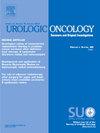目前的做法和变化动态前哨淋巴结活检的阴茎癌:一项调查的欧洲转诊中心。
IF 2.3
3区 医学
Q3 ONCOLOGY
Urologic Oncology-seminars and Original Investigations
Pub Date : 2025-08-06
DOI:10.1016/j.urolonc.2025.06.022
引用次数: 0
摘要
背景:动态前哨淋巴结活检(DSNB)是目前高危阴茎癌(PeCa)合并cN0疾病患者首选的分期方法。最近,在手术入路和技术上有了进步。本研究的目的是比较当代DSNB的做法和技术之间的欧洲转诊中心。材料和方法:一份在线调查被发送给EAU YAU阴茎和睾丸癌工作组的成员。这些问题深入到DSNB的各个方面,包括成像技术、示踪剂、手术方法和术后患者护理。还要求各参与中心以标准化方式提供DSNB程序的录象,以便对技术上的细微差别进行比较分析。结果:我们收到了来自9个欧洲中心的12名泌尿科医生的回复。总体而言,83%和42%的外科医生每年分别进行10万例和50例DSNB手术。对示踪剂注射的技术和部位有广泛的共识。相反,50%的中心使用淋巴显像,17%使用SPECT/CT, 33%同时使用两种成像方式。染料的主要选择是专利V/蓝色,但25%的中心使用吲哚菁绿(ICG)。手术切口位置和淋巴结扎技术存在显著的差异。大家一致倾向于不留下伤口。总体而言,83%的中心采用抗生素手术预防,83%的中心在术后停止使用抗生素。四分之一的中心将提倡患者出院时使用血栓预防,要么使用低分子肝素,要么使用血栓栓塞威慑袜。术后平均住院时间为1天。结论:各中心对PeCa行DSNB手术的程序和术后管理存在差异。一些欧洲中心使用了荧光成像和SPECT/CT等较新的技术,但高质量的证据很少,这突出了对手术结果和新兴技术进行广泛的多中心研究的必要性。本文章由计算机程序翻译,如有差异,请以英文原文为准。
Current practices and variability in dynamic sentinel node biopsy for penile cancer: A survey of European Referral Centers
Background
Dynamic sentinel node biopsy (DSNB) is the currently preferred staging method of high-risk penile cancer (PeCa) patients with cN0 disease. Recently, there have been advancements in the surgical approach and techniques. This study aims to compare the contemporary DSNB practice and techniques amongst European referral centers.
Materials and Methods
An online survey was sent to members of the EAU YAU Penile and Testis Cancer working group. These questions delved into various facets of DSNB, encompassing imaging techniques, tracers, surgical approaches, and postoperative patient care. Participating centers were also required to provide video-recorded DSNB procedures in a standardized manner for a comparative analysis of technical nuances.
Results
Responses were received from twelve Urologists from nine European centers. Overall, 83% and 42% of surgeons performed >10 and >50 DSNB procedures per year, respectively. There is a broad consensus on the technique and site of tracer injections. Conversely, 50% of centers use lymphoscintigraphy, 17% use SPECT/CT, while 33% utilize both imaging modalities. The predominant choice of dye is Patent V/blue, but 25% of centers use Indocyanine Green (ICG). Notable variability exists in surgical incision sites and lymphatic ligation techniques. The consensus is leaning towards not leaving a wound drain. Overall, 83% of centers adopt antibiotic surgical prophylaxis, with 83% discontinuing it postoperatively. A quarter of centers would advocate for patients to be discharged with thromboprophylaxis, either using low molecular weight heparin or thromboembolic deterrent stockings. On average, the postoperative length of stay in hospital is 1 day.
Conclusions
Variation exists in procedural aspects and postoperative management among centers performing DSNB for PeCa. Newer technologies like fluorescence imaging and SPECT/CT are used in some European centers, but high-quality evidence is sparse, highlighting the need for extensive multicenter research into surgical outcomes and emerging technologies.
求助全文
通过发布文献求助,成功后即可免费获取论文全文。
去求助
来源期刊
CiteScore
4.80
自引率
3.70%
发文量
297
审稿时长
7.6 weeks
期刊介绍:
Urologic Oncology: Seminars and Original Investigations is the official journal of the Society of Urologic Oncology. The journal publishes practical, timely, and relevant clinical and basic science research articles which address any aspect of urologic oncology. Each issue comprises original research, news and topics, survey articles providing short commentaries on other important articles in the urologic oncology literature, and reviews including an in-depth Seminar examining a specific clinical dilemma. The journal periodically publishes supplement issues devoted to areas of current interest to the urologic oncology community. Articles published are of interest to researchers and the clinicians involved in the practice of urologic oncology including urologists, oncologists, and radiologists.

 求助内容:
求助内容: 应助结果提醒方式:
应助结果提醒方式:


